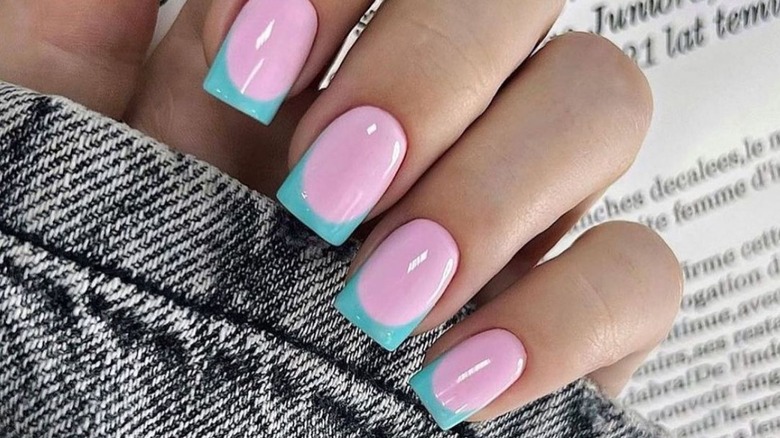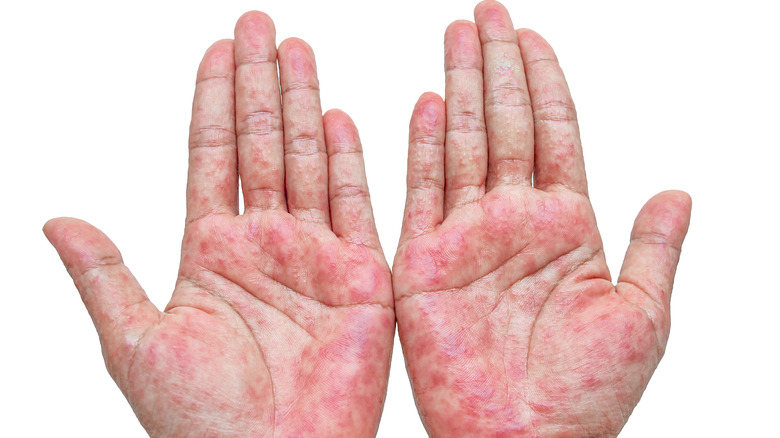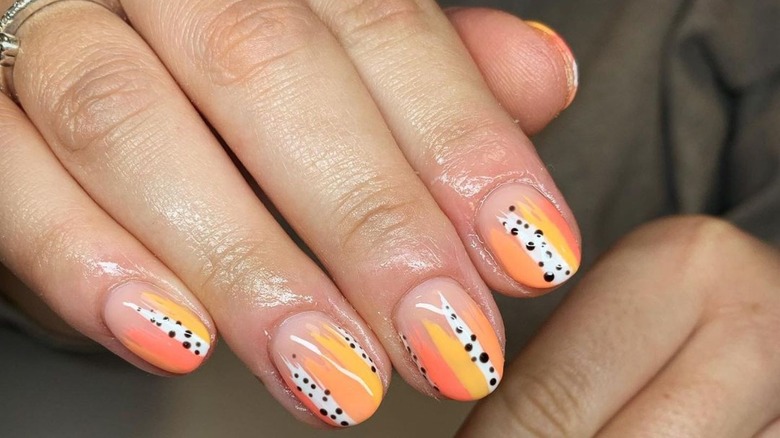Why You Should Avoid This Viral Nail Polish Application Hack
Social media serves up lots of beauty hacks that we can get behind, like this simple way to remove those pesky elastics or the frozen makeup sponge trick. And there's usually no shortage of users willing to test them and post their results, which can save you from learning the hard way that some things are just too good to be true.
Take, for example, the new viral nail polish application hack making the rounds on TikTok. The trend has to do with creating the perfect French line for a classic French manicure. Typically this style involves painting or stamping a line across the tippy top of your nail. You can alter this look in many ways to suit your tastes, whether it be a chunky 90s-inspired French manicure or the more modern, open lines of a lip liner French manicure. Regardless of your Frenchie style, the hardest part is getting that smooth, symmetrical, dainty line.
Enter DIY, minimal-tools-needed, French line hacks — some of which have gone viral and should be avoided.
What's the hack?
The hack consists of painting your base coat on each of your fingernails as you normally would. After letting them dry, paint your line color onto one pad of your finger. Yes, that's correct, not your nail but the center of your finger pad near the tip (and this is where it can get problematic, as you'll see). Working quickly, press the top of each nail of the opposite hand into the polish on your pad. Repeat on the other side. Supposedly, you can vary your French line's thickness and shape by rotating your finger or pressing harder.
If you've been on social media or considered yourself even a little adept at nails, you probably think this looks like a similar trick. And you would be right. The finger pad method is just like using a makeup sponge, or the sometimes pricier silicone stamper. The difference is you don't need a fancy tool to get a great manicure. But ...
While you may think that saving money by not buying yet another beauty tool sounds great, here's why you should carefully consider some of the hacks you see online.
Is it really worth it?
We may have cringed a little when we saw nail polish being applied to the skin, and rightly so. After all, the instructions advise that nail polish is for your nails, not your skin. Additionally, you must take that nail polish off your finger, probably requiring the sometimes harsh chemicals found in nail polish remover.
Some manufacturers state that nail polish is bad for your skin, warning that it can dry it out, dehydrating your body's protective layer. Furthermore, some of the chemicals may go through your skin, which is permeable, and enter your bloodstream. Similarly, acetone, the main ingredient of most removers, is equally drying and harmful.
Experts are anti-nail polish on the skin, too, cautioning that it could cause contact dermatitis. Characterized by an itchy rash, contact dermatitis results from your skin coming into contact with a substance that is irritating or causes an allergic reaction. Certain products, like nail polishes, can cause the condition. Dermatologist Maris Garshick, M.D. told InStyle, "While not everyone will experience contact dermatitis, in someone who is already sensitive to certain ingredients in the nail polish, it can occur even after brief contact." Never mind the prolonged exposure you experience while stamping all of your nail tips.
Save your skin
The best way to prevent contact dermatitis is to avoid triggers, like not painting fingernail polish on your skin, for starters. Not only will the polish chemicals stay away from your skin, but you'll also diminish the need to apply nail polish remover as well.
If you do find yourself with lacquer on your fingers or hands, starting with a non-acetone remover is generally better than a harsher product. Remover is often the quickest way, but you may be able to use coconut oil too. The polish should eventually unstick itself from your skin with a bit of rubbing. After either removal method, be sure to wash your hands with soap and water. If you're left with a stain, the founder of JinSoon nail spa, Jin Soon Choi, says "Applying some toothpaste is good for stained nails as well as skin," (via Well + Good).
Pre-polish, you may want to consider applying Vaseline around your fingertips, cuticles, and surrounding areas of skin using a Q-tip. It acts as a nice barrier between you and the polish. DIY manicurists have used cuticle oil, Elmer's glue, and good old Scotch tape as other barrier methods. You'll want to make sure to let the polish dry before removing the barrier. And, of course, we don't recommend trying a barrier on your finger pad and then attempting the hack. Opt for a silicone stamper or the traditional method of painting and filling an outline instead.


